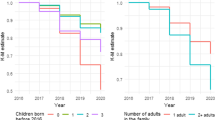Abstract
In order to assess how expansion of day care facilities affects fertility, the Norwegian Family and Occupation Survey of 1988 was linked with individual register-based migration histories and time-series data on day-care coverage rates in all Norwegian municipalities. Many factors affect both the allocation of resources to day-care centers and a woman's probability of giving birth. The local coverage rate is positively associated with the probability of advancing from parity two, after control for geographical region, degree of urbanization and other confounders. This effect of day-care supply, which is significant at low coverage levels, contributed to a moderate rise in third-birth rates after the mid-1970s. However, if the aggregate employment rate for women is also regarded as a confounder, the effect of day care may actually be insignificant. Moreover, the effect fades at higher coverage levels. Finally, there are indications that second- and first-birth probabilities decline with increasing provision of day care. These results suggest that further efforts to improve the supply of private and public day care - which in Norway are likely to be motivated by non-demographic concerns - will have little stimulating effect on fertility, at least if the subsidies and quality of care remain unchanged.
Similar content being viewed by others
References
Arjas, E. & Kangas, P. (1992). A discrete-time method for the analysis of event histories, in: J. Trussell, R. Hankinson & J. Tilton (eds.), Demographic applications of event history analysis. Oxford: Clarendon Press.
Blanchet, D. (1987). Les effets démographiques de différentes mesures de politique familiale: Un essai d'évalution, Population 42: 99–128.
Blau, D.M. & Robins, P.K. (1989). Fertility, employment and child-care costs, Demography 26: 287–299.
Blix, K.W. (1991). Etterspørselen etter barnehageplasser, INAS Notat. Oslo: Institute for Social Research.
Büttner, T. & Lutz, W. (1990). Estimating fertility responses to policy measures in the German Democratic Republic, Population and Development Review 16: 539–555.
Butz, W.P. & Ward, M.P. (1979). The emergence of countercyclical US fertility, American Economic Review 69: 318–328.
Connelly, R. (1992). The effect of child care costs on married women's labor force participation, The Review of Economics and Statistics 74: 83–90.
Ekert, O. (1986). Effets et limites des aides financières aux familles: Une expérience et un modèle, Population 41: 327–348.
Ermisch, J. (1989). Purchased child care, optimal family size and mother's employment, Journal of Population Economics 2: 79–102.
Gauthier, A.H. (1991). Family policies in comparative perspective, Discussion Paper 5. Oxford: Centre for European Studies, Nuffield College.
Gauthier, A.H. (1993). Towards renewed fears of population and family decline, European Journal of Population 9: 143–167.
Gustafsson, S. & Stafford, F. (1992). Child care subsidies and labor supply in Sweden, Journal of Human Resources 27: 204–230.
Hoem, J.M. (1990). Social policy and recent fertility change in Sweden, Population and Development Review 16: 735–748.
Hoem, B. & Hoem, J.M. (1989), The impact of female employment on second and third births in modern Sweden, Population Studies 43: 47–67.
Höhn, C. (1987). Population policies in advanced societies, European Journal of Population 3: 459–481.
Kravdal, Ø. (1992a). The weak impact of female labour force participation on Norwegian third-birth rates, European Journal of Population 8: 247–263.
Kravdal, Ø. (1992b). The emergence of a positive relation between education and third birth rates in Norway with supportive evidence from the United States, Population Studies 46: 459–475.
Kravdal, Ø. (1994a). Components of the recent fertility increase in Norway: Period and cohort perspectives, in Ø. Kravdal, Sociodemographic studies of fertility and divorce in Norway with emphasis on the importance of economic factors, SØS 90. Oslo: Statistics Norway.
Kravdal, Ø. (1994b). The importance of economic activity, economic potential and economic resources for the timing of first births in Norway, Population Studies 48: 249–267.
Kristiansen, J.E. (1993). Barnehagetilsyn, in Statistics Norway (eds.), Sosialt Utsyn. Oslo.
Lehrer, E. & Kawasaki, S. (1985). Child care arrangements and fertility: An analysis of two-earner households, Demography 22: 499–513.
Leibowitz, A., Klerman, J.A. & L.J. Waite (1992). Employment of new mothers and child care choices: Differences by children's age, Journal of Human Resources 27: 112–133.
McRae, S. (1993). Returning to work after childbirth: Opportunities and inequalities, European Sociological Review 9: 125–137.
Mason, K.O. & Kuhlthau, K. (1992). The perceived impact of child care costs on women's labor supply and fertility, Demography 29: 523–543.
Ministry of Finance (1993). Langtidsprogrammet 1994–1997, Stortingsmelding 4. Oslo.
Murphy, M. (1993). The contraceptive pill and women's employment as factors in fertility change in Britain 1963–1980: A challenge to the conventional view, Population Studies 47: 221–244.
Nordic Statistical Secretariat (1991). Yearbook of Nordic Statistics. Copenhagen.
Presser, H.B. & Baldwin, W. (1980). Child care as a constraint on employment: Prevalence, correlates, and bearing on the work and fertility nexus, American Journal of Sociology 85: 1202–1213.
Prioux, F. (1990). Fertility and family size in Western Europe, Population English Selection 2: 141–161.
Sataøen, S.O. (1990). Mot full barnehagedekning, Rapport 13/90. Sogndal: Vestlandsforskning.
Statistics Norway (1985). Standard for kommuneklassifisering, Standarder for norsk statistikk 4. Oslo.
Statistics Norway (1991). Familieog yrkesundersøkelsen 1988, NOS B 959. Oslo.
Statistics Norway (1992a). Barnehager og tilbud til 6-åringer i skolen 1991, NOS C 53. Oslo.
Statistics Norway (1992b). Levekårs-undersøkelsen, NOS C 43. Oslo.
Stolzenberg, R.M. & Waite, L.J. (1984). Local labor markets, children and labor force participation of wives, Demography 21: 157–170.
Sundström, M. and Stafford, F.P. (1992). Female labour force participation, fertility and public policy in Sweden, European Journal of Population 8: 199–216.
Sørlie, K. (1993). Bofasthet, flytting og utdanningsnivå i kommunene, Reports 93/30. Oslo: Statistics Norway.
Tungland, E. & Hauge, J. (1991). På vei mot full barnehagedekning, Rapport RF 40/91. Stavanger: Rogalandsforskning.
Wright, R.E., Ermisch, J.F., Hinde, P.R.A. & Joshi, H.E. (1988). The third birth in Great Britain, Journal of Biosocial Science 20: 489–496.
Author information
Authors and Affiliations
Rights and permissions
About this article
Cite this article
Kravdal, Ø. How the local supply of day-care centers influences fertility in Norway: A parity-specific approach. Popul Res Policy Rev 15, 201–218 (1996). https://doi.org/10.1007/BF00127049
Issue Date:
DOI: https://doi.org/10.1007/BF00127049




